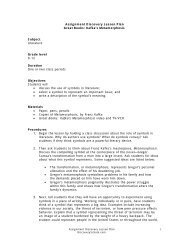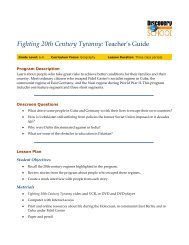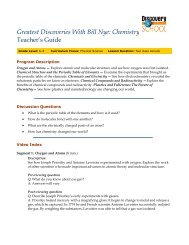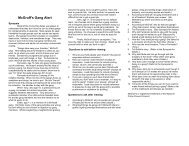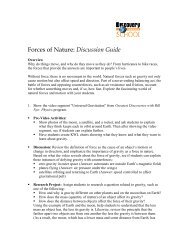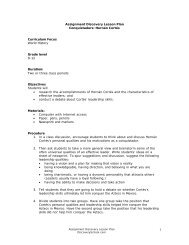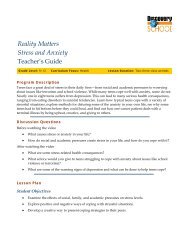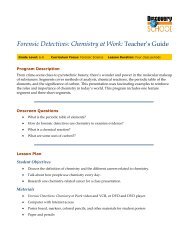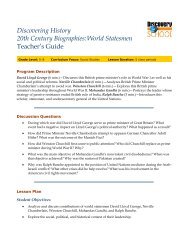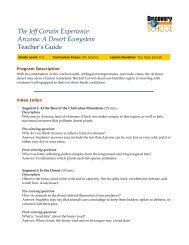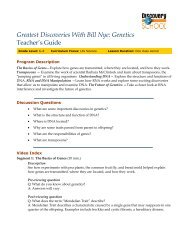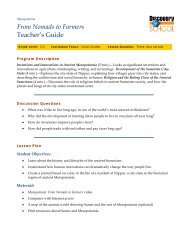Last of the Czars: Dynasty in Decline - Discovery Education
Last of the Czars: Dynasty in Decline - Discovery Education
Last of the Czars: Dynasty in Decline - Discovery Education
You also want an ePaper? Increase the reach of your titles
YUMPU automatically turns print PDFs into web optimized ePapers that Google loves.
<strong>Last</strong> <strong>of</strong> <strong>the</strong> <strong>Czars</strong>: <strong>Dynasty</strong> <strong>in</strong> Decl<strong>in</strong>e:<br />
Teacher’s Guide<br />
Grade Level: 9-12 Curriculum Focus: World History Lesson Duration: Two class periods<br />
Program Description<br />
For 300 years, <strong>the</strong> Romanov family ruled Russia until a Len<strong>in</strong>-backed revolution ended <strong>the</strong> reign<br />
with <strong>the</strong>ir violent deaths. New <strong>in</strong>formation gleaned from never-before-seen footage, actual letters,<br />
czarist-era survivor <strong>in</strong>terviews, photos, and o<strong>the</strong>r rare items gives a f<strong>in</strong>ely detailed look at this<br />
country's most dramatic dynasty and era. A <strong>Dynasty</strong> <strong>in</strong> Decl<strong>in</strong>e — Nicholas II saw his czarist hold<br />
on <strong>the</strong> country crumble when Len<strong>in</strong>'s Bolshevik Party and tragic events, such as <strong>the</strong> <strong>in</strong>famous<br />
"Bloody Sunday," brought constitutional monarchy to <strong>the</strong> fore. Meet Nicholas and Alexandra, <strong>the</strong>ir<br />
four daughters and only son, and <strong>the</strong> czar's mysterious confidant, Rasput<strong>in</strong>. (Video 1 <strong>of</strong> <strong>Last</strong> <strong>of</strong><br />
<strong>Czars</strong> 2-pack.)<br />
Onscreen Questions and Activities<br />
Segment 1, <strong>Last</strong> <strong>of</strong> <strong>the</strong> <strong>Czars</strong>: A <strong>Dynasty</strong> <strong>in</strong> Decl<strong>in</strong>e: Part One<br />
• Pre-view<strong>in</strong>g questions:<br />
o The czarist system <strong>in</strong> Russia was a lot like <strong>the</strong> monarchies <strong>in</strong> o<strong>the</strong>r European<br />
countries. What do you already know about <strong>the</strong> czarist form <strong>of</strong> government?<br />
o As you watch <strong>the</strong> documentary, keep track <strong>of</strong> <strong>the</strong> warn<strong>in</strong>g signs that <strong>the</strong> people were<br />
becom<strong>in</strong>g dissatisfied with <strong>the</strong> system.<br />
• Post-view<strong>in</strong>g questions: The documentary expla<strong>in</strong>s that <strong>the</strong> foundations <strong>of</strong> <strong>the</strong> Romanov faith<br />
were orthodoxy, autocracy, and nationality. Discuss what this means and how it might have<br />
helped to keep <strong>the</strong> czarist system <strong>of</strong> government <strong>in</strong> place for so long.<br />
• Activity: Choose an event that took place <strong>in</strong> Russia dur<strong>in</strong>g Nicholas’s reign. Then, write a diary<br />
entry or letter about this event from <strong>the</strong> perspective <strong>of</strong> one <strong>of</strong> <strong>the</strong> Romanovs. Make sure your<br />
writ<strong>in</strong>g reflects history accurately.<br />
Segment 2, <strong>Last</strong> <strong>of</strong> <strong>the</strong> <strong>Czars</strong>: A <strong>Dynasty</strong> <strong>in</strong> Decl<strong>in</strong>e: Part Two<br />
• Pre-view<strong>in</strong>g questions:<br />
o Dur<strong>in</strong>g Nicholas’s rule, <strong>the</strong> Duma was created as a parliamentary system. What do<br />
you already know about this system <strong>of</strong> government?
<strong>Last</strong> <strong>of</strong> <strong>the</strong> <strong>Czars</strong>: A <strong>Dynasty</strong> <strong>in</strong> Decl<strong>in</strong>e: Teacher’s Guide 2<br />
o As you watch <strong>the</strong> documentary, pay attention to <strong>the</strong> relationship between Czar<br />
Nicholas II and <strong>the</strong> Duma.<br />
• Post-view<strong>in</strong>g questions: The Duma was opposed to <strong>the</strong> Russian <strong>in</strong>volvement <strong>in</strong> World War I.<br />
Review <strong>the</strong> reasons why Russia became <strong>in</strong>volved <strong>in</strong> <strong>the</strong> war. Why do you th<strong>in</strong>k <strong>the</strong>re was<br />
<strong>in</strong>ternal opposition to Russia’s <strong>in</strong>volvement?<br />
• Activity: Research <strong>the</strong> causes <strong>of</strong> World War I and <strong>the</strong> military responses <strong>of</strong> <strong>the</strong> nations<br />
<strong>in</strong>volved. Then, create a diagram show<strong>in</strong>g <strong>the</strong> alliance system that mobilized itself at <strong>the</strong> start<br />
<strong>of</strong> <strong>the</strong> war.<br />
Lesson Plan<br />
Student Objectives<br />
Students will understand:<br />
• Historians can form a picture <strong>of</strong> a society based on primary sources such as diaries <strong>of</strong> people<br />
who lived through a period.<br />
• Photographs, diaries, and letters from Nicholas II’s family have helped historians better<br />
understand <strong>the</strong>ir life and times.<br />
Materials<br />
• <strong>Last</strong> <strong>of</strong> <strong>the</strong> <strong>Czars</strong>: A <strong>Dynasty</strong> <strong>in</strong> Decl<strong>in</strong>e video and VCR, or DVD and DVD player<br />
• Resources about Nicholas II and <strong>the</strong> Romanovs (biographies, history textbooks, encyclopedias)<br />
• Computer with Internet access<br />
Procedures<br />
1. Ask students to review basic facts about Nicholas II from <strong>the</strong> video. Expla<strong>in</strong> that <strong>the</strong>ir<br />
assignment will be to research more <strong>in</strong>formation about this czar and write a diary entry by <strong>the</strong><br />
dethroned, exiled emperor. Students should assume that <strong>the</strong>y are compos<strong>in</strong>g <strong>the</strong> imag<strong>in</strong>ary<br />
entries <strong>in</strong> Ekater<strong>in</strong>burg, where members <strong>of</strong> <strong>the</strong> royal family were isolated by <strong>the</strong> Communists<br />
from April 26, 1918, until <strong>the</strong>ir murder a few months later.<br />
2. Expla<strong>in</strong> to students that we have no pro<strong>of</strong> that Nicholas II kept a journal at Ekater<strong>in</strong>burg, so this<br />
assignment conta<strong>in</strong>s an element <strong>of</strong> <strong>the</strong> hypo<strong>the</strong>tical. Expla<strong>in</strong> that we know, however, that<br />
keep<strong>in</strong>g diaries, tak<strong>in</strong>g photographs, and writ<strong>in</strong>g letters were common <strong>in</strong> Nicholas’s family.<br />
This creative writ<strong>in</strong>g assignment will demonstrate students’ grasp <strong>of</strong> <strong>the</strong> facts surround<strong>in</strong>g <strong>the</strong><br />
decl<strong>in</strong>e <strong>of</strong> <strong>the</strong> Romanov dynasty.<br />
3. Discuss with students’ <strong>the</strong> role personal diaries can play <strong>in</strong> piec<strong>in</strong>g toge<strong>the</strong>r history. Inform<br />
students that historians have used diaries <strong>of</strong> both <strong>the</strong> powerful and <strong>the</strong> common folk <strong>in</strong> form<strong>in</strong>g<br />
a picture <strong>of</strong> a period. Ask students whe<strong>the</strong>r <strong>the</strong>y th<strong>in</strong>k people writ<strong>in</strong>g <strong>in</strong> diaries are truthful<br />
Published by <strong>Discovery</strong> <strong>Education</strong>. © 2005. All rights reserved.
<strong>Last</strong> <strong>of</strong> <strong>the</strong> <strong>Czars</strong>: A <strong>Dynasty</strong> <strong>in</strong> Decl<strong>in</strong>e: Teacher’s Guide 3<br />
(because <strong>the</strong>y th<strong>in</strong>k <strong>the</strong> entries are private) or slanted (because <strong>the</strong> writer wants to look good or<br />
may be self-deceived about his or her reality) or both.<br />
4. Have <strong>the</strong> class bra<strong>in</strong>storm some topics that <strong>the</strong>y, role-play<strong>in</strong>g Nicholas, should cover <strong>in</strong> a diary<br />
entry. These topics should give students an opportunity to demonstrate facts <strong>the</strong>y’ve learned<br />
about Nicholas. Examples <strong>of</strong> diary topics <strong>in</strong>clude <strong>the</strong> follow<strong>in</strong>g:<br />
• Nicholas’s reputation among <strong>the</strong> peasantry at this time<br />
• Nicholas’s feel<strong>in</strong>gs toward his wife <strong>of</strong> more than 20 years<br />
• Nicholas’s feel<strong>in</strong>gs toward his four daughters<br />
• Nicholas’s concerns about his son<br />
• Nicholas’s most recent thoughts about Rasput<strong>in</strong><br />
• Nicholas’s feel<strong>in</strong>gs toward <strong>the</strong> Bolsheviks<br />
In addition, direct students to <strong>in</strong>clude diary passages by Nicholas based on students’ <strong>in</strong>telligent<br />
guesses as to what he might say about <strong>the</strong> follow<strong>in</strong>g, undocumented topics:<br />
• The act he is most proud <strong>of</strong> carry<strong>in</strong>g out as czar<br />
• His greatest regret as leader <strong>of</strong> <strong>the</strong> Russian people<br />
• His view <strong>of</strong> <strong>the</strong> future for himself, his family, and Russia<br />
5. Provide or have students ga<strong>the</strong>r appropriate resources about Nicholas II and <strong>the</strong> Romanovs.<br />
6. When students have drafted and revised <strong>the</strong>ir diary entries, have <strong>the</strong>m exchange work and<br />
comment on each o<strong>the</strong>r’s entries. Students should po<strong>in</strong>t out to each o<strong>the</strong>r any unclear sections<br />
that might confuse readers who come across Nicholas’s diary <strong>in</strong> <strong>the</strong> future. Writers should<br />
revise <strong>the</strong>ir entries to clarify such sections.<br />
7. After you’ve collected students’ work, lead a discussion about <strong>the</strong> assignment. What did<br />
students like about it? What did <strong>the</strong>y dislike? What did <strong>the</strong>y get out <strong>of</strong> <strong>the</strong> assignment?<br />
Discussion Questions<br />
1. Describe <strong>the</strong> relationship <strong>of</strong> Czar Nicholas and his wife Alexandra, and relate how <strong>the</strong>ir<br />
relationship would contribute to <strong>the</strong>ir fall from power dur<strong>in</strong>g <strong>the</strong> Russian Revolution.<br />
2. Nicholas and Alexandra wrote many long love letters to one ano<strong>the</strong>r. Nicholas also took many<br />
pictures <strong>of</strong> his family. What can you <strong>in</strong>fer from <strong>the</strong> letters and photos <strong>of</strong> <strong>the</strong> Romanov family?<br />
Bra<strong>in</strong>storm a list <strong>of</strong> qualities <strong>of</strong> <strong>the</strong> family.<br />
3. Did <strong>the</strong> actions <strong>of</strong> Nicholas II toward <strong>the</strong> Russian people dur<strong>in</strong>g such <strong>in</strong>cidents as <strong>the</strong> massacre<br />
<strong>of</strong> January 9, 1905 show that he was an autocratic ruler? How did politics under <strong>the</strong> czar’s<br />
government differ from politics under <strong>the</strong> democratic government <strong>of</strong> <strong>the</strong> United States <strong>of</strong> <strong>the</strong><br />
same period?<br />
4. Describe <strong>the</strong> structure <strong>of</strong> Russian society around <strong>the</strong> time <strong>of</strong> Nicholas II and relate <strong>the</strong> social<br />
structure <strong>of</strong> Russian society to <strong>the</strong> political events <strong>of</strong> <strong>the</strong> time. What were o<strong>the</strong>r Eurasian<br />
Published by <strong>Discovery</strong> <strong>Education</strong>. © 2005. All rights reserved.
<strong>Last</strong> <strong>of</strong> <strong>the</strong> <strong>Czars</strong>: A <strong>Dynasty</strong> <strong>in</strong> Decl<strong>in</strong>e: Teacher’s Guide 4<br />
countries’ political structures like dur<strong>in</strong>g that period? Were <strong>the</strong>y similar or different? How do<br />
you th<strong>in</strong>k <strong>the</strong> similarities and differences contributed to <strong>the</strong> unpopularity <strong>of</strong> <strong>the</strong> Romanovs?<br />
5. Compare Russian politics under <strong>the</strong> czar with that <strong>of</strong> modern Russian politics dur<strong>in</strong>g <strong>the</strong> late<br />
1990s. Pay special attention to <strong>the</strong> relationship <strong>of</strong> <strong>the</strong> Duma with <strong>the</strong> chief executive.<br />
6. Hypo<strong>the</strong>size why it was so easy for <strong>the</strong> monk Rasput<strong>in</strong> to work his way <strong>in</strong>to <strong>the</strong> lives <strong>of</strong> <strong>the</strong><br />
czar’s family. What characteristics did he have that allowed him to have such sway over <strong>the</strong><br />
royal family? Why do you believe he became close to Alexandra?<br />
7. Outl<strong>in</strong>e several reasons why you th<strong>in</strong>k democracy was doomed <strong>in</strong> Russia around <strong>the</strong> time <strong>of</strong><br />
<strong>the</strong> czar.<br />
8. How is Russian support for <strong>the</strong> Serbs <strong>in</strong> <strong>the</strong> Balkans today similar to its support dur<strong>in</strong>g <strong>the</strong> time<br />
<strong>of</strong> <strong>the</strong> czars? How is it different? Support your answer with specific examples from current<br />
events.<br />
Assessment<br />
Use <strong>the</strong> follow<strong>in</strong>g three-po<strong>in</strong>t rubric to evaluate students' work dur<strong>in</strong>g this lesson.<br />
• 3 po<strong>in</strong>ts: Student’s diary entry <strong>in</strong>cludes many statements about <strong>the</strong> topics on <strong>the</strong> bra<strong>in</strong>storm<strong>in</strong>g<br />
list and that reflect familiarity with <strong>the</strong> facts <strong>of</strong> Nicholas’s life up to this po<strong>in</strong>t; <strong>in</strong>cludes<br />
reasonable predictions that Nicholas, logically, may have made at this po<strong>in</strong>t.<br />
• 2 po<strong>in</strong>ts: Student’s diary entry <strong>in</strong>cludes a few statements about <strong>the</strong> topics on <strong>the</strong> bra<strong>in</strong>storm<strong>in</strong>g<br />
list and that reflect familiarity with <strong>the</strong> facts <strong>of</strong> Nicholas’s life up to this po<strong>in</strong>t; <strong>in</strong>cludes farfetched<br />
predictions by Nicholas.<br />
• 1 po<strong>in</strong>t: Student’s diary entry does not address topics on <strong>the</strong> bra<strong>in</strong>storm<strong>in</strong>g list and does not<br />
reflect familiarity with <strong>the</strong> facts <strong>of</strong> Nicholas’s life up to this po<strong>in</strong>t; does not provide Nicholas’s<br />
predictions.<br />
Vocabulary<br />
assass<strong>in</strong>ation<br />
Def<strong>in</strong>ition: The murder <strong>of</strong> a political figure.<br />
Context: The trauma <strong>of</strong> assass<strong>in</strong>ation was to haunt Nicholas II all his life.<br />
autocrat<br />
Def<strong>in</strong>ition: A person with unlimited power or authority.<br />
Context: After Nicholas signed <strong>the</strong> Constitution <strong>of</strong> 1905, he rel<strong>in</strong>quished his power as absolute<br />
autocrat.<br />
Bolshevik<br />
Def<strong>in</strong>ition: The communist party <strong>of</strong> Russia and eventually <strong>of</strong> <strong>the</strong> Soviet Union. Formed by<br />
Vladimir Len<strong>in</strong> <strong>in</strong> 1903, <strong>the</strong> party was first a faction <strong>of</strong> <strong>the</strong> Russian Social Democratic Labour<br />
Party (RSDLP).<br />
Published by <strong>Discovery</strong> <strong>Education</strong>. © 2005. All rights reserved.
<strong>Last</strong> <strong>of</strong> <strong>the</strong> <strong>Czars</strong>: A <strong>Dynasty</strong> <strong>in</strong> Decl<strong>in</strong>e: Teacher’s Guide 5<br />
Context: Dur<strong>in</strong>g its early years, <strong>the</strong> czar did not pay much attention to <strong>the</strong> newly formed<br />
Bolshevik party.<br />
Cossacks<br />
Def<strong>in</strong>ition: An ethnic group with<strong>in</strong> Russian society found on <strong>the</strong> steppes <strong>of</strong> western Russia and<br />
<strong>the</strong> Ukra<strong>in</strong>e region, used by <strong>the</strong> czars as an <strong>in</strong>ternal police force to quell civil unrest. The<br />
Cossacks also participated <strong>in</strong> numerous upris<strong>in</strong>gs aga<strong>in</strong>st <strong>the</strong> czarist government.<br />
Context: The Cossacks were partially responsible for <strong>the</strong> deaths that resulted from <strong>the</strong><br />
demonstrations that took place on Bloody Sunday, January 9, 1905.<br />
czar or tsar<br />
Def<strong>in</strong>ition: The emperor or monarch <strong>of</strong> Russia.<br />
Context: Alexander was taught <strong>the</strong> basics <strong>of</strong> be<strong>in</strong>g a Romanov: orthodoxy, autocracy, and<br />
nationality—<strong>the</strong> Church, <strong>the</strong> czar, and Russia.<br />
Duma<br />
Def<strong>in</strong>ition: The first nationally elected Russian parliament.<br />
Context: The czar and czar<strong>in</strong>a came to <strong>the</strong> W<strong>in</strong>ter Palace for <strong>the</strong> ceremonial open<strong>in</strong>g <strong>of</strong> <strong>the</strong> first<br />
Duma.<br />
dynasty<br />
Def<strong>in</strong>ition: A l<strong>in</strong>e <strong>of</strong> rulers who come from <strong>the</strong> same family. Also, <strong>the</strong> period <strong>of</strong> time that <strong>the</strong>y<br />
rule over a nation.<br />
Context: The Romanov dynasty ruled Russia for 300 years.<br />
heir<br />
Def<strong>in</strong>ition: The child <strong>of</strong> a k<strong>in</strong>g or queen dest<strong>in</strong>ed to become <strong>the</strong> re<strong>in</strong><strong>in</strong>g monarch after <strong>the</strong> death<br />
<strong>of</strong> <strong>the</strong> rul<strong>in</strong>g k<strong>in</strong>g or queen. Also, <strong>the</strong> child who receives <strong>the</strong> <strong>in</strong>heritance after <strong>the</strong> death <strong>of</strong> <strong>the</strong><br />
parent.<br />
Context: The Romanov family had four female children, but <strong>the</strong>y needed a male to be <strong>the</strong> heir to<br />
<strong>the</strong> Russian throne.<br />
<strong>in</strong>terloper<br />
Def<strong>in</strong>ition: A person who meddles <strong>in</strong> <strong>the</strong> affairs <strong>of</strong> o<strong>the</strong>rs, usually for selfish reasons.<br />
Context: The Russian people came to perceive <strong>the</strong> czar<strong>in</strong>a as an <strong>in</strong>terloper, a German spy, and<br />
<strong>the</strong> source <strong>of</strong> <strong>the</strong> country’s misfortunes.<br />
propaganda<br />
Def<strong>in</strong>ition: Any public <strong>in</strong>formation designed to conv<strong>in</strong>ce or persuade someone to do, believe, or<br />
buy someth<strong>in</strong>g.<br />
Context: The Russian people believed <strong>the</strong> propaganda about <strong>the</strong> Russo-Japanese war, which<br />
promised swift victory.<br />
Published by <strong>Discovery</strong> <strong>Education</strong>. © 2005. All rights reserved.
<strong>Last</strong> <strong>of</strong> <strong>the</strong> <strong>Czars</strong>: A <strong>Dynasty</strong> <strong>in</strong> Decl<strong>in</strong>e: Teacher’s Guide 6<br />
Academic Standards<br />
Mid-cont<strong>in</strong>ent Research for <strong>Education</strong> and Learn<strong>in</strong>g (McREL)<br />
McREL's Content Knowledge: A Compendium <strong>of</strong> Standards and Benchmarks for K-12 <strong>Education</strong><br />
addresses 14 content areas. To view <strong>the</strong> standards and benchmarks, visit<br />
http://www.mcrel.org/compendium/browse.asp.<br />
This lesson plan addresses <strong>the</strong> follow<strong>in</strong>g national standards:<br />
• World History—An Age <strong>of</strong> Revolutions: Understand major global trends from 1750 to 1914.<br />
• World History—An Age <strong>of</strong> Revolutions: Understands patterns <strong>of</strong> global change <strong>in</strong> <strong>the</strong> era <strong>of</strong><br />
Western military and economic dom<strong>in</strong>ance from 1800 to 1914.<br />
• World History—A Half-Century <strong>of</strong> Crisis and Achievement: Understands reform,<br />
revolution, and social change <strong>in</strong> <strong>the</strong> world economy <strong>of</strong> <strong>the</strong> early 20th century.<br />
• World History—A Half-Century <strong>of</strong> Crisis and Achievement: Understands <strong>the</strong> causes and<br />
global consequences <strong>of</strong> World War I.<br />
The National Council for <strong>the</strong> Social Studies (NCSS)<br />
The National Council for <strong>the</strong> Social Studies (NCSS) has developed national standards to provide<br />
guidel<strong>in</strong>es for teach<strong>in</strong>g social studies. To view <strong>the</strong> standards onl<strong>in</strong>e, go to<br />
http://www.socialstudies.org/standards/strands/.<br />
This lesson plan addresses <strong>the</strong> follow<strong>in</strong>g <strong>the</strong>matic standards:<br />
• Time, Cont<strong>in</strong>uity, and Change<br />
Support Materials<br />
Develop custom worksheets, educational puzzles, onl<strong>in</strong>e quizzes, and more with <strong>the</strong> free teach<strong>in</strong>g tools<br />
<strong>of</strong>fered on <strong>the</strong> <strong>Discovery</strong>school.com Web site. Create and pr<strong>in</strong>t support materials, or save <strong>the</strong>m to a<br />
Custom Classroom account for future use. To learn more, visit<br />
• http://school.discovery.com/teach<strong>in</strong>gtools/teach<strong>in</strong>gtools.html<br />
Published by <strong>Discovery</strong> <strong>Education</strong>. © 2005. All rights reserved.



